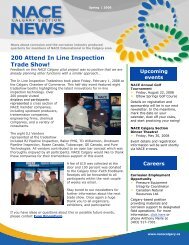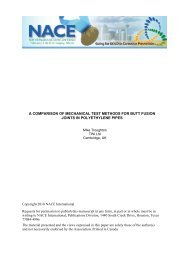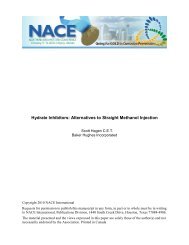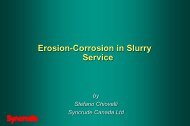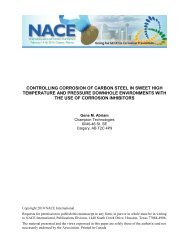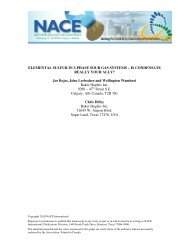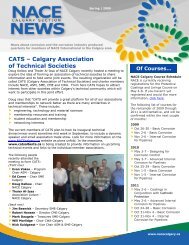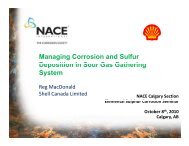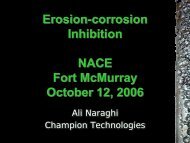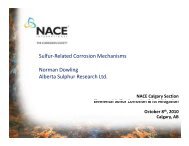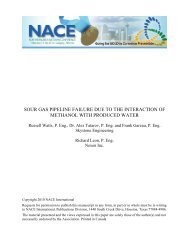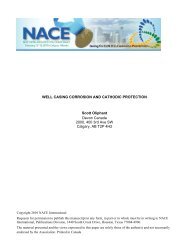Quality Control of Cathodic Field Records - NACE Calgary
Quality Control of Cathodic Field Records - NACE Calgary
Quality Control of Cathodic Field Records - NACE Calgary
You also want an ePaper? Increase the reach of your titles
YUMPU automatically turns print PDFs into web optimized ePapers that Google loves.
QUALITY CONTROL OF CATHODIC PROTECTION FIELD RECORDS<br />
Written by:<br />
W. Brian Holtsbaum P.Eng.<br />
Presented by:<br />
Paul B. Charlebois<br />
DNV Canada Ltd.<br />
#123 – 2340 Pegasus Way NE<br />
<strong>Calgary</strong> AB T2E 8M5<br />
Copyright 2010 <strong>NACE</strong> International<br />
Requests for permission to publish this manuscript in any form, in part or in whole must be in writing to<br />
<strong>NACE</strong> International, Publications Division, 1440 South Creek Drive, Houston, Texas 77084-4906.<br />
The material presented and the views expressed in this paper are solely those <strong>of</strong> the author(s) and not<br />
necessarily endorsed by the Association. Printed in Canada
ABSTRACT<br />
<strong>Field</strong> data is required to document the field tests and to support a conclusion as to the<br />
operation <strong>of</strong> the cathodic protection (CP) system, that is, to confirm if a criterion has been met.<br />
Later it can be used as historical data to support an External Corrosion Direct Assessment<br />
(ECDA) or in the event <strong>of</strong> an incident it may become evidence in court that is available to all<br />
parties.<br />
The past method <strong>of</strong> documentation <strong>of</strong> cathodic protection tests <strong>of</strong>ten makes it very<br />
difficult if not impossible for a proper analysis as the field notes leave many unanswered<br />
questions. If used in court, poor record keeping provides an opportunity for the opposition in<br />
court to discredit the data.<br />
<strong>Field</strong> personnel spend a great deal <strong>of</strong> time and effort in accessing a measurement<br />
location but then fail to spend the few minutes <strong>of</strong> extra time required to properly document the<br />
data. There is no acceptable reason for lack <strong>of</strong> documentation.<br />
The CP industry needs to establish improved minimum detailed standards for field notes<br />
that later can be easily understood by those not exposed to the test and also will be solid court<br />
evidence. Technology is now available for improved and controlled data collection. This<br />
provides the opportunity to ensure that all necessary data is documented but to include<br />
provision for the analysis <strong>of</strong> this data.<br />
Keywords: CP Data, documentation, ECDA, records, data quality, quality control, CP<br />
criterion<br />
INTRODUCTION<br />
Documentation <strong>of</strong> cathodic protection (CP) field tests is required to provide a historical<br />
record and to support a conclusion as to the operation <strong>of</strong> a CP system and if a criterion has<br />
been met. If the structure being protected is regulated, in Canada and the USA, this<br />
documentation must be made annually with bi-monthly monitoring <strong>of</strong> the system during the<br />
year. If it is not regulated, such practice is considered as best industry practice and should still<br />
be followed.<br />
These records can later be used as historical data to support an External Corrosion<br />
Direct Assessment (ECDA) or in the unfortunate event <strong>of</strong> an incident they may become<br />
evidence in court and available to all parties.<br />
CGA OCC-1-2005, Section 6 1 and <strong>NACE</strong> SP-0169-2007 Section 11 2 both describe<br />
records that are pertinent to design, installation, maintenance and effectiveness <strong>of</strong> external<br />
corrosion control measures in general terms and although these are a minimum requirement<br />
even these terms are not always met in our CP records. More detailed information that needs<br />
to be documented is provided with the intent that the CP industry will improve field data<br />
standards. Many <strong>of</strong> these points should be obvious but they are detailed as they are <strong>of</strong>ten not<br />
recorded.<br />
There are rigid requirements for detailed requirements for CP records and as a result<br />
the information documented is <strong>of</strong>ten sparse with many assumptions left to the reader. This
not only makes it very difficult or impossible for a proper analysis <strong>of</strong> the field notes but in the<br />
event that they become evidence in court, the lack <strong>of</strong> information also provides an opportunity<br />
for the opposition in court to discredit the data. Regulated companies must store information<br />
for the life <strong>of</strong> the structure therefore, at a later date this information must be easily understood<br />
by those that were not familiar with the test<br />
Technological advances in data acquisition and storage are now available to this<br />
industry. These allow a more accurate recording and thorough analysis <strong>of</strong> more complete<br />
data.<br />
PAST PRACTICES<br />
There were a multitude <strong>of</strong> methods <strong>of</strong> recording CP data in use and a few methods are<br />
described.<br />
Prior to computers all data was recorded on paper. This may be on loose pages in a binder,<br />
clip board or a hard bound note book. With loose pages, there is a risk <strong>of</strong> pages getting lost or<br />
damaged. In addition, recording data on loose pages may not be acceptable as a legal<br />
defense since pages can be substituted with revised data at a later time. Originally only a hard<br />
bound book was acceptable in court and, if a mistake was made, the incorrect information was<br />
not erased but crossed out.<br />
Another method is to preprint a table on loose pages that anticipate the required<br />
information. If the table is blank, the readings will be recorded in the order taken but if the<br />
table has locations inserted the chronological order <strong>of</strong> the readings is not known. In addition<br />
pages can be lost, inserted in the wrong order and revised at a later date. Preprinting<br />
locations also sends a message to the tester that this is the only information that is needed.<br />
With continual modifications made in the field additional readings should always be expected.<br />
An extension <strong>of</strong> the above method is to record data on last year’s hard copy report.<br />
This is unacceptable as the chronological order <strong>of</strong> taking readings is not known and <strong>of</strong>ten data<br />
with irrelevant comments from the prior year is copied into the next year’s report.<br />
The use <strong>of</strong> a hard bound book such as that used by land surveyors has worked well in<br />
the past (Figure 1). They are available in a convenient pocket size and also in waterpro<strong>of</strong><br />
paper. A book should be reserved for a particular system or area so that easy reference can<br />
be made at a later time. The disadvantage <strong>of</strong> the book is that it requires the tester to enter all<br />
information on each page.<br />
The disadvantage <strong>of</strong> all hard copy methods is that they normally need to be transcribed<br />
into a file document.<br />
With laptop computers in the vehicle, data can be typed directly into the computer in the<br />
field. This has the advantage that the data can be processed without transcribing it at a later<br />
time. Unfortunately there is a high risk <strong>of</strong> error in entering the data directly and since this is the<br />
original copy the accuracy can not be confirmed.<br />
The safest method to record data electronically is to use a voltmeter with a memory but<br />
many dataloggers require manual entry <strong>of</strong> other information. Technology is available now that
the readings, GPS location date and time can be automatically entered with the measurement.<br />
Although there is a risk <strong>of</strong> making typographical errors in entering remarks, the other key data<br />
itself will be recorded automatically and accurately by the instrument. This information can be<br />
downloaded to a computer and processed in another file. The original file from the instrument<br />
must be stored unaltered.<br />
BASIC RECORD REQUIREMENTS<br />
Regardless <strong>of</strong> the method <strong>of</strong> recording, the following information is considered as the<br />
basic essential information.<br />
Name<br />
Although it is obvious that the tester’s name(s) should be on the data, in many cases it is<br />
not. The tester must take responsibility for the readings and one must know who to contact<br />
with any questions regarding the data. The training, experience, certifications and other<br />
qualifications <strong>of</strong> the tester(s) need to be with the data to establish competence and therefore<br />
the quality <strong>of</strong> the information.<br />
Date and Time<br />
The date and time <strong>of</strong> each measurement including power supply readings and<br />
potentials is to be recorded to allow an analysis <strong>of</strong> the chronological order <strong>of</strong> the readings.<br />
Those readings taken before and after a rectifier adjustment or the repair <strong>of</strong> a shorted isolation<br />
must be known.<br />
The date <strong>of</strong> the installation, repair or replacement <strong>of</strong> cathodic protection equipment must<br />
be known.<br />
If the data is to be transcribed on to a spreadsheet, this information needs to be on each<br />
row to keep relevant information during a “data sort”.<br />
Weather and Ground Conditions<br />
Measurements can change due to temperature conditions and to the ground conditions.<br />
Readings taken in January compared to those obtained in July may be different due to the<br />
temperature change <strong>of</strong> the reference electrode (0.9 mV/ o C) 3 and to frozen versus thawed soils<br />
rather than due to a change in the operation <strong>of</strong> the cathodic protection system. There is a<br />
possibility <strong>of</strong> poor reference electrode contact to soil under either frozen or extremely dry soil<br />
conditions which can cause an error <strong>of</strong> ±20% or more <strong>of</strong> the true value. Knowledge <strong>of</strong> the<br />
environmental conditions is therefore important.<br />
Location<br />
In Western Canada reading locations can be related to legal land divisions <strong>of</strong> townships,<br />
sections and legal subdivisions (LSD) that provide a location to within 1/16 th <strong>of</strong> a one (1)<br />
square mile section. This may be accurate enough for a well location however it may not be<br />
accurate for a location on a pipeline.
Global Positioning System (GPS) locations can now be taken to locate most readings.<br />
This works well in the field but a drawing or map with these co-ordinates is needed to help<br />
relate the locations to each other. Instruments are now available to record this information<br />
directly.<br />
In addition to the general geographical location, the detailed location <strong>of</strong> the<br />
measurement also needs to be defined. For example, when recording a structure-toelectrolyte<br />
potential, the point <strong>of</strong> contact to the structure and location <strong>of</strong> the reference electrode<br />
must be identified. The point <strong>of</strong> contact not only describes which structure potential is being<br />
taken but can also determine electrical continuity along the structure. The reference electrode<br />
must be left in one position to establish the effectiveness <strong>of</strong> an isolating fitting but leaving the<br />
reference over the same side does not give a true potential <strong>of</strong> the structure on the other side <strong>of</strong><br />
the isolating fitting. Therefore additional readings must be taken and each identified<br />
accordingly in this case.<br />
DC Power Supplies<br />
Since cathodic protection must be maintained continuously, the need to inspect and<br />
keep complete records <strong>of</strong> the CP dc power source is obvious. The information that is needed<br />
is the complete name plate data, voltage and current output, the tap setting or equivalent and if<br />
applicable, circuit outputs all as found and as left. If available the power service KWH readings<br />
should also be taken.<br />
One measurement that is seldom obtained is the dc back emf with the rectifier turned <strong>of</strong>f<br />
temporarily which is a measurement <strong>of</strong> the galvanic difference between the anode and the<br />
structure. The back emf opposes the rectifier voltage and therefore is a critical component <strong>of</strong> a<br />
true calculation <strong>of</strong> the overall circuit resistance calculated in equation 1.<br />
Where:<br />
R<br />
E<br />
E b<br />
E Eb R = ( − )<br />
…1<br />
I<br />
- Circuit resistance (Ohms)<br />
- Rectifier output voltage when operating (Volts)<br />
- Rectifier back emf measured with rectifier <strong>of</strong>f (Volts)<br />
If the back emf is not considered, the circuit resistance appears to change with a<br />
change in the output voltage especially at a lower circuit resistance and/or a lower voltage<br />
output.<br />
When there are two (2) or more dc power supplies, there is a point between each set <strong>of</strong><br />
units where the influence <strong>of</strong> one ends to be taken over by the next one. If one unit should go<br />
<strong>of</strong>f, this point <strong>of</strong> influence then moves into the territory <strong>of</strong> the de-energized unit thus current is<br />
still influencing this area (Figure 2). When recording true polarized (instant <strong>of</strong>f) structure-toelectrolyte<br />
potentials, it is important to know which DC power supplies have an influence over<br />
the section being tested and all <strong>of</strong> these units must be synchronously interrupted to measure a<br />
true polarized potential. Unless it is planned to interrupt all units on a known synchronized<br />
cycle, area <strong>of</strong> influence surveys need to be completed for each DC power source and clearly
documented. In both cases, the DC power sources that are interrupted or the cycles <strong>of</strong><br />
interruption during each test segment needs to be recorded.<br />
The number <strong>of</strong> relocated rectifiers with reversed polarity connections is an<br />
embarrassment to industry. This occurs as a lack <strong>of</strong> training and an appreciation <strong>of</strong> the<br />
catastrophic consequences <strong>of</strong> accelerated corrosion that occurs with this error. Only trained<br />
cathodic protection personnel should be allowed to re-energize a new or relocated rectifier<br />
after appropriate testing. The polarity <strong>of</strong> the unit itself can be confirmed by noting the polarity <strong>of</strong><br />
a portable voltmeter connected to the DC output but this does not confirm that the DC cables<br />
are connected correctly. The latter can only be confirmed by a structure-to-electrolyte potential<br />
with the current <strong>of</strong>f and on noting a more electronegative potential with the current on (Figure<br />
3). The fact that this test has been completed needs to be documented.<br />
Determination <strong>of</strong> a CP Criterion<br />
In the absence <strong>of</strong> evidence that corrosion has not occurred, there are essentially two<br />
criteria that can be used. These include a polarized structure-to-electrolyte potential or a<br />
polarization criterion. In the first case the polarized potential can be determined by either<br />
interrupting all influencing DC power sources and measuring the polarized potential directly as<br />
an “instant <strong>of</strong>f” potential or by measuring the “on” potential and eliminating the IR drop<br />
component that is determined by some means (equation 2).<br />
E<br />
p<br />
= E = E − E<br />
…2<br />
Where<br />
<strong>of</strong>f<br />
E p<br />
E <strong>of</strong>f<br />
E on<br />
E IR<br />
on<br />
IR<br />
- Polarized structure-to-electrolyte potential<br />
- Instant <strong>of</strong>f structure-to-electrolyte potential<br />
- Structure-to-electrolyte potential with current applied<br />
- Voltage drop in the electrolyte between the reference electrode and the<br />
structure surface with current applied.<br />
The polarization criterion is determined by the difference between the polarized<br />
potential and either the native p`otential or the depolarized potential (equation 3).<br />
∆E<br />
∆E<br />
pol<br />
pol<br />
= E<br />
= E<br />
<strong>of</strong>f<br />
<strong>of</strong>f<br />
− E<br />
− E<br />
native<br />
depol<br />
Where:<br />
E pol - Polarization<br />
E <strong>of</strong>f - Instant <strong>of</strong>f structure-to-electrolyte potential<br />
E native - Structure-to-electrolyte potential before CP applied<br />
E depol - Structure-to-electrolyte potential after CP current has been turned <strong>of</strong>f<br />
If proving a polarization criterion by decay, “instant <strong>of</strong>f” and “native” or “depolarized”<br />
potentials are taken at the same reference electrode position for each location. In the first part<br />
<strong>of</strong> equation 3, the native potentials are measured and then after time is allowed for polarization<br />
the polarized (instant <strong>of</strong>f) potentials are obtained. The difference between the “instant on” and<br />
the “final on” is due to polarization if practical to take these measurements. In the second part<br />
…3
<strong>of</strong> equation 3, the instant <strong>of</strong>f potentials are recorded and after time is allowed for<br />
depolarization, the depolarized potentials are then recorded.<br />
If the minimum amount <strong>of</strong> polarization (depolarization) can be seen by datalogging the<br />
on / <strong>of</strong>f cycles and if sufficient, the second survey would not be necessary with this information.<br />
Figure 4 is an example <strong>of</strong> an immediate measurement <strong>of</strong> depolarization for the 100 mV<br />
criterion however in this case the -850 mV CSE polarized potential criterion was also met.<br />
Depending on the criterion to be proven, there is a considerable amount <strong>of</strong> information<br />
that needs to be recorded. This would include the following information for each reading<br />
location in addition to the name, date and time described above.<br />
• Point <strong>of</strong> contact to the structure<br />
• Reference electrode position<br />
• Structure-to-electrolyte potential with the current applied<br />
• If applicable, the native potential, the potential with the current interrupted<br />
momentarily and/or the depolarized potential.<br />
• Remarks applicable to the measurements or structure.<br />
Interference Test Data Requirements<br />
Stray current interference can cause corrosion even on a structure that has cathodic<br />
protection. Unfortunately, interference testing and documenting the results <strong>of</strong> these tests is<br />
<strong>of</strong>ten taken very lightly which may be due to the difficulty in conducting the tests properly and<br />
the costs associated with detailed tests.<br />
Interference is <strong>of</strong>ten assumed to occur only at pipeline crossings or at isolating features.<br />
In the latter case the same test to determine the effectiveness <strong>of</strong> an isolating fitting, that is, a<br />
fixed reference electrode test, is <strong>of</strong>ten used as an interference test. This is incorrect as the:<br />
• interfering DC power source may not be interrupted<br />
• reference electrode position may not be at the interfered-with structure and<br />
• point(s) <strong>of</strong> maximum exposure can be at another location<br />
Due to the amount <strong>of</strong> organization required to conduct a n interference test properly,<br />
when an it is to be completed as a part <strong>of</strong> an adjustive survey, the interference test is <strong>of</strong>ten<br />
minimized even though it is the test that deserves a great deal <strong>of</strong> attention. In such cases it<br />
would be planned as a separate test as the consequences <strong>of</strong> interference can be significant.<br />
Proper documentation <strong>of</strong> all steps <strong>of</strong> an interference test must be made.
In addition to the tester’s name, date and time, the information that needs to be<br />
documented for steady state stray current interference includes:<br />
• With mitigation disconnected, and the interfered-with CP system operating record<br />
“on” / “<strong>of</strong>f” “interfered-with” structure-to-electrolyte potentials with reference at this<br />
structure while the “interfering” dc power source is interrupted.<br />
• With mitigation disconnected and “interfered-with” CP system not operating,<br />
measure “on” and “<strong>of</strong>f” potentials (reference at “interfered-with” structure) with<br />
“interfering” dc power source interrupted.<br />
• With mitigation connected and “interfered-with” CP system operating, record “on”<br />
potentials (reference at “interfered-with” structure) with interfering dc power source<br />
operating.<br />
• With mitigation connected and “interfered-with” CP system not operating, record<br />
potentials (reference over “interfered-with” structure) with interfering dc power<br />
source interrupted. (Note that “<strong>of</strong>f” potentials with bonds in place are no longer a<br />
valid polarized structure-to-electrolyte potential.)<br />
• In all cases the effect <strong>of</strong> mitigation on the “interfering” structure should also be<br />
measured.<br />
• Record current associated with the mitigation equipment.<br />
• Record the dc power source data <strong>of</strong> the “interfering” and the “interfered-with”<br />
systems.<br />
Spreadsheet <strong>Records</strong><br />
In the past records have been transcribed into spreadsheets such as shown in Figure 5.<br />
Although at first glance it appears there is sufficient information recorded there are deficiencies<br />
and also it does not take advantage <strong>of</strong> the features <strong>of</strong> a spreadsheet such as sorting. A data<br />
sort is useful to summarize all sub-criterion potentials, to sort by chronological tests or to sort<br />
by location.<br />
The deficiencies in Figure 5 include:<br />
• the type <strong>of</strong> reference electrode used is not indicated<br />
• “Other” potentials are listed in the wrong columns,<br />
• current is listed under the potential column with units <strong>of</strong> milliVolts<br />
• multiple information is listed under “Location” that will not be tracked if a data sort<br />
was attempted. In fact a data sort will not be successful with data in this<br />
arrangement.<br />
Figure 6 is a sample <strong>of</strong> pipe-to-electrolyte potential data format that could be sorted without a<br />
loss <strong>of</strong> identification and associated remarks. Figure 7 is additional critical bond data that<br />
could be incorporated into Figure 6 or handled separately.<br />
FUTURE QUALITY CONTROL<br />
The cathodic protection industry needs to embrace the technology that is available<br />
today to improve the quality <strong>of</strong> the field data.
GPS datalog type voltmeters are now available and equipped with many functions<br />
(Figure 8). This allows potential measurements at different locations to be compared at<br />
precisely the same moment. S<strong>of</strong>tware is also available to process this information to facilitate<br />
the analysis <strong>of</strong> this data (Figure 9).<br />
The instrument automatically enters the routine information <strong>of</strong> date, time and GPS<br />
location with the actual readings thus eliminating the possibility <strong>of</strong> human error in entering this<br />
information.<br />
Using this equipment, a series <strong>of</strong> data can be obtained at each reading location that will<br />
provide a pr<strong>of</strong>ile <strong>of</strong> the potentials as the power source is interrupted. This clearly provides a<br />
more accurate instant <strong>of</strong>f potential as opposed to reading a digital voltmeter display.<br />
In addition the amount <strong>of</strong> depolarization in the “<strong>of</strong>f” cycle chosen is evident at the<br />
stationary location and may cause a change in the interruption cycle selected (Figure 9). If the<br />
rectifiers should go out <strong>of</strong> synchronization, the stationary datalogger will illustrate this fact and<br />
also the length <strong>of</strong> time that is necessary for the instant <strong>of</strong>f measurement to be accurately<br />
captured (Figure 10).<br />
The effect <strong>of</strong> telluric current or dynamic stray current will be evident by observing the<br />
change in potential with time either at the stationary datalog or at the portable datalog location<br />
(Figure 11). Both the raw data and the corrected data must be filed for such cases.<br />
CONCLUSIONS<br />
The cathodic protection industry needs to establish and require higher minimum<br />
standards for cathodic protection records beyond that required by the present code or<br />
standards.<br />
The cathodic protection industry needs to embrace the new technology which <strong>of</strong>fers the<br />
opportunity to capture and greatly assist with the assessment <strong>of</strong> cathodic protection test data.
FIGURES<br />
FIGURE 1: Typical Hard Bound <strong>Field</strong> Book<br />
A B C<br />
Current<br />
Pipe Current Direction with all Rectifiers On<br />
Pipe Current Direction with Rectifier B Off<br />
Distance<br />
FIGURE 2: Changing Rectifier Influence With a Rectifier Off
Rectifier<br />
Rectifier Polarity OK<br />
BUT<br />
NOTE<br />
With cables connected as shown,<br />
With cables connected correctly,<br />
Polairty OK potential will go more electropositive potential will go more electronegative<br />
when rectifier comes on<br />
when rectifier comes on<br />
( + ) ( - )<br />
Current Interrupter<br />
( + ) ( - )<br />
CSE Reference Electrode<br />
Cables Reversed<br />
Underground<br />
Anodes<br />
Structure<br />
FIGURE 3: Testing for Correct DC Polarity<br />
FIGURE 4: Datalog <strong>of</strong> an Interrupted Pipe-to-Electrolyte Potential with Time
Notes:<br />
A - Reference electrode type not indicated<br />
B - Location information is not on the same line as data thus it will be separated in a sort or search<br />
C - Foreign potentials in IPF "Structure" column instead <strong>of</strong> "Other"<br />
D - Current in Potential column suggesting it is a structure-to-electrolyte potential and is in mV.<br />
E - Multiple information is in Location column making a search or sort impractical<br />
FIGURE 5: Data Transcribed Incorrectly into a Spreadsheet<br />
Date<br />
xx-xx-xx<br />
xx-xx-xx<br />
Time<br />
Location "Other" GPS<br />
Potential (-mV CSE)*<br />
Contact<br />
(Legal (Foreign<br />
Structure Other<br />
North West<br />
to<br />
Description) Owner)<br />
On Off On Off<br />
Reference Remarks By<br />
xx.xx<br />
01-02-03-04<br />
CSE over IF tested<br />
XYZ Oil xx°xx.xxx' xxx°xx.xxx' -1100 -1000 -1050 -950 I/F<br />
W4M<br />
NPS 6 line good<br />
J Doe<br />
xx.xx<br />
01-02-03-04<br />
CSE over<br />
XYZ Oil xx°xx.xxx' xxx°xx.xxx' -1200 -1100 -800 -900 I/F<br />
W4M<br />
NPS 4 line<br />
J Doe<br />
* Same reference position for readings in same row<br />
FIGURE 6: Pipe-to-Electrolyte Potential Data transcribed into a Spreadsheet to allow a Data<br />
Sort<br />
Time<br />
xx.xx<br />
xx.xx<br />
GPS<br />
POTENTIAL ( -mv ) see Note A<br />
STRUCTURE OTHER<br />
LOCATION NORTH W EST LINE ON OFF ON OFF REMARKS<br />
01-02-03-<br />
04 W4M xx°xx.xxx'xxx°xx.xxx' see Note B<br />
CB#xx<br />
xxx<br />
Owner -1100 -1000 Bond Connected<br />
XYZ Oil -1050 -950 see Note C<br />
Current 150 60 see Note D<br />
Owner xxx -1200 -1100 Bond Disconnected<br />
XYZ Oil -800 -900 see Note C<br />
Current 0 0 see Note D<br />
see Note E<br />
Location<br />
(Legal<br />
Descripti<br />
01-02-03-<br />
04 W4M<br />
"Other"<br />
(Foreign<br />
Owner)<br />
North<br />
GPS<br />
West<br />
Critical<br />
Bond #<br />
Bond<br />
Bond Current** (mA)<br />
XYZ Oil xx°xx.xxx'xxx°xx.xxx' CB#xx Across I/F +150 +60 XYZ Oil Bond Connected J Doe<br />
01-02-03-<br />
04 W4M XYZ Oil xx°xx.xxx'xxx°xx.xxx' CB#xx Across I/F 0 0 XYZ Oil Bond temporarily<br />
J Doe<br />
disconnected<br />
ON<br />
OFF<br />
Bond<br />
Critical to<br />
Remarks<br />
** Positive current is from Foreign to Owner through bond<br />
By<br />
FIGURE 7: Bond Current Data Transcribed into a Spreadsheet to allow a Data Sort
FIGURE 8: Sample datalog type instrument<br />
KP 430.88 SDL Log around 8:40 MDT<br />
Time (s)<br />
0 2 4 6 8 10 12<br />
-1800<br />
-1600<br />
Reference Cell Potential (mV CSE)<br />
-1400<br />
-1200<br />
-1000<br />
FIGURE 9: Datalog <strong>of</strong> Rectifier Synchronized Interruption
KP 430.88 SDL Log around 14:05 MDT<br />
Time (s)<br />
0 2 4 6 8 10 12<br />
-1800<br />
-1600<br />
Reference Cell Potential (mVCSE)<br />
-1400<br />
-1200<br />
-1000<br />
FIGURE 10: Datalog with Nearby Rectifier out <strong>of</strong> Synchronization<br />
(Off Reading must be delayed)<br />
CC Technologies<br />
A DNV COMPANY<br />
I n n o v a t i v e S o l u t i o n s<br />
SDL Chart - PriL<br />
On Potential Off Potential CIS On Potential CIS Off Potential<br />
080604 TG SO 88 PriL 7+350 SDL 4 RD HM.txt Standard Deviation: 0.058 V Mean (Auto): -1.489 V<br />
-2.4<br />
-2.3<br />
-2.2<br />
-2.1<br />
-2<br />
-1.9<br />
-1.8<br />
-1.7<br />
Potential (Vcse)<br />
-1.6<br />
-1.5<br />
-1.4<br />
-1.3<br />
-1.2<br />
-1.1<br />
-1<br />
-0.9<br />
-0.8<br />
-0.7<br />
-0.6<br />
-0.5<br />
-1<br />
CIS Off (Original)<br />
CIS Off (Compensated)<br />
Potential (Vcse)<br />
-0.9<br />
-0.8<br />
-0.7<br />
-0.6<br />
-0.5<br />
8:45 AM<br />
8:50 AM<br />
8:55 AM<br />
9:00 AM<br />
9:05 AM<br />
9:10 AM<br />
9:15 AM<br />
9:20 AM<br />
9:25 AM<br />
9:30 AM<br />
Timestamp<br />
9:35 AM<br />
9:40 AM<br />
9:45 AM<br />
9:50 AM<br />
9:55 AM<br />
10:00 AM<br />
10:05 AM<br />
10:10 AM<br />
10:15 AM<br />
FIGURE 11: Stationary and Portable Datalog <strong>of</strong> Potentials affected by Telluric Current
REFERENCES<br />
1. Canadian Gas Association, CGA OCC-1-2005, <strong>Control</strong> <strong>of</strong> External Corrosion on Buried or<br />
Submerged Metallic Piping Systems<br />
2. <strong>NACE</strong> International, <strong>NACE</strong> SP0169-2007, Standard Practice, <strong>Control</strong> <strong>of</strong> External Corrosion<br />
on Underground or Submerged Metallic Piping Systems<br />
3. Frank J. Ansuini, James R. Dimond, Factors Affecting the Accuracy <strong>of</strong> Reference<br />
Electrodes, Materials Performance Vol. 33 No. 11 November 1994



